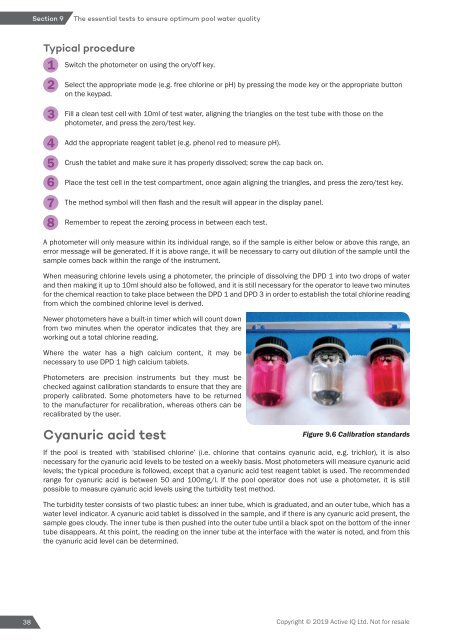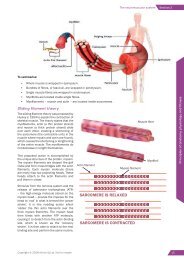Active IQ Level 2 Award in Pool Operations (sample manual)
For more information, please visit https://www.activeiq.co.uk/qualifications/level-2/active-iq-level-2-award-in-pool-operations
For more information, please visit https://www.activeiq.co.uk/qualifications/level-2/active-iq-level-2-award-in-pool-operations
You also want an ePaper? Increase the reach of your titles
YUMPU automatically turns print PDFs into web optimized ePapers that Google loves.
Section 9<br />
The essential tests to ensure optimum pool water quality<br />
Typical procedure<br />
1 Switch the photometer on us<strong>in</strong>g the on/off key.<br />
2<br />
Select the appropriate mode (e.g. free chlor<strong>in</strong>e or pH) by press<strong>in</strong>g the mode key or the appropriate button<br />
on the keypad.<br />
3<br />
4<br />
5<br />
Fill a clean test cell with 10ml of test water, align<strong>in</strong>g the triangles on the test tube with those on the<br />
photometer, and press the zero/test key.<br />
Add the appropriate reagent tablet (e.g. phenol red to measure pH).<br />
Crush the tablet and make sure it has properly dissolved; screw the cap back on.<br />
6 Place the test cell <strong>in</strong> the test compartment, once aga<strong>in</strong> align<strong>in</strong>g the triangles, and press the zero/test key.<br />
7<br />
8<br />
The method symbol will then flash and the result will appear <strong>in</strong> the display panel.<br />
Remember to repeat the zero<strong>in</strong>g process <strong>in</strong> between each test.<br />
A photometer will only measure with<strong>in</strong> its <strong>in</strong>dividual range, so if the <strong>sample</strong> is either below or above this range, an<br />
error message will be generated. If it is above range, it will be necessary to carry out dilution of the <strong>sample</strong> until the<br />
<strong>sample</strong> comes back with<strong>in</strong> the range of the <strong>in</strong>strument.<br />
When measur<strong>in</strong>g chlor<strong>in</strong>e levels us<strong>in</strong>g a photometer, the pr<strong>in</strong>ciple of dissolv<strong>in</strong>g the DPD 1 <strong>in</strong>to two drops of water<br />
and then mak<strong>in</strong>g it up to 10ml should also be followed, and it is still necessary for the operator to leave two m<strong>in</strong>utes<br />
for the chemical reaction to take place between the DPD 1 and DPD 3 <strong>in</strong> order to establish the total chlor<strong>in</strong>e read<strong>in</strong>g<br />
from which the comb<strong>in</strong>ed chlor<strong>in</strong>e level is derived.<br />
Newer photometers have a built-<strong>in</strong> timer which will count down<br />
from two m<strong>in</strong>utes when the operator <strong>in</strong>dicates that they are<br />
work<strong>in</strong>g out a total chlor<strong>in</strong>e read<strong>in</strong>g.<br />
Where the water has a high calcium content, it may be<br />
necessary to use DPD 1 high calcium tablets.<br />
Photometers are precision <strong>in</strong>struments but they must be<br />
checked aga<strong>in</strong>st calibration standards to ensure that they are<br />
properly calibrated. Some photometers have to be returned<br />
to the manufacturer for recalibration, whereas others can be<br />
recalibrated by the user.<br />
Cyanuric acid test<br />
Figure 9.6 Calibration standards<br />
If the pool is treated with ‘stabilised chlor<strong>in</strong>e’ (i.e. chlor<strong>in</strong>e that conta<strong>in</strong>s cyanuric acid, e.g. trichlor), it is also<br />
necessary for the cyanuric acid levels to be tested on a weekly basis. Most photometers will measure cyanuric acid<br />
levels; the typical procedure is followed, except that a cyanuric acid test reagent tablet is used. The recommended<br />
range for cyanuric acid is between 50 and 100mg/l. If the pool operator does not use a photometer, it is still<br />
possible to measure cyanuric acid levels us<strong>in</strong>g the turbidity test method.<br />
The turbidity tester consists of two plastic tubes: an <strong>in</strong>ner tube, which is graduated, and an outer tube, which has a<br />
water level <strong>in</strong>dicator. A cyanuric acid tablet is dissolved <strong>in</strong> the <strong>sample</strong>, and if there is any cyanuric acid present, the<br />
<strong>sample</strong> goes cloudy. The <strong>in</strong>ner tube is then pushed <strong>in</strong>to the outer tube until a black spot on the bottom of the <strong>in</strong>ner<br />
tube disappears. At this po<strong>in</strong>t, the read<strong>in</strong>g on the <strong>in</strong>ner tube at the <strong>in</strong>terface with the water is noted, and from this<br />
the cyanuric acid level can be determ<strong>in</strong>ed.<br />
38<br />
Copyright © 2019 <strong>Active</strong> <strong>IQ</strong> Ltd. Not for resale

















